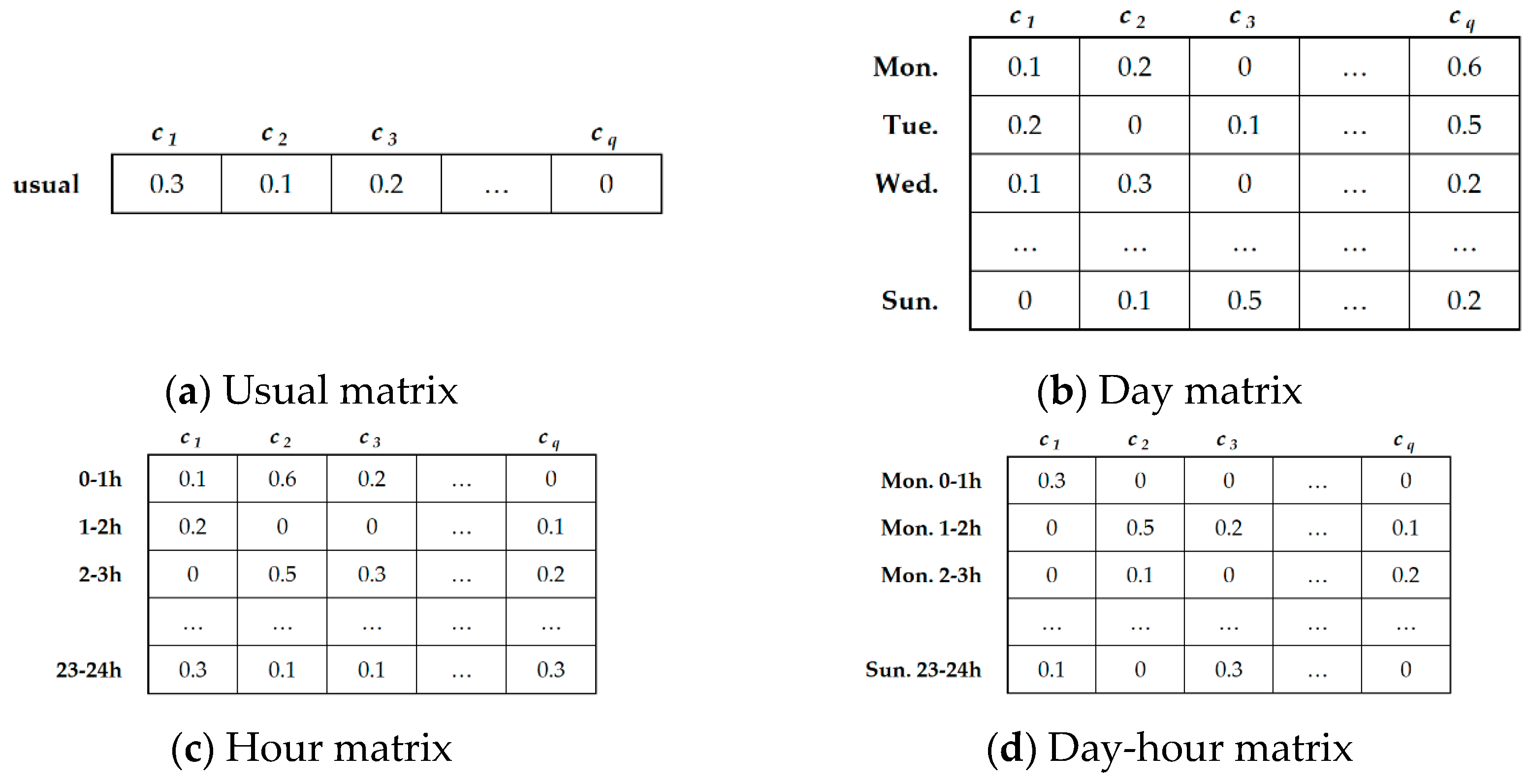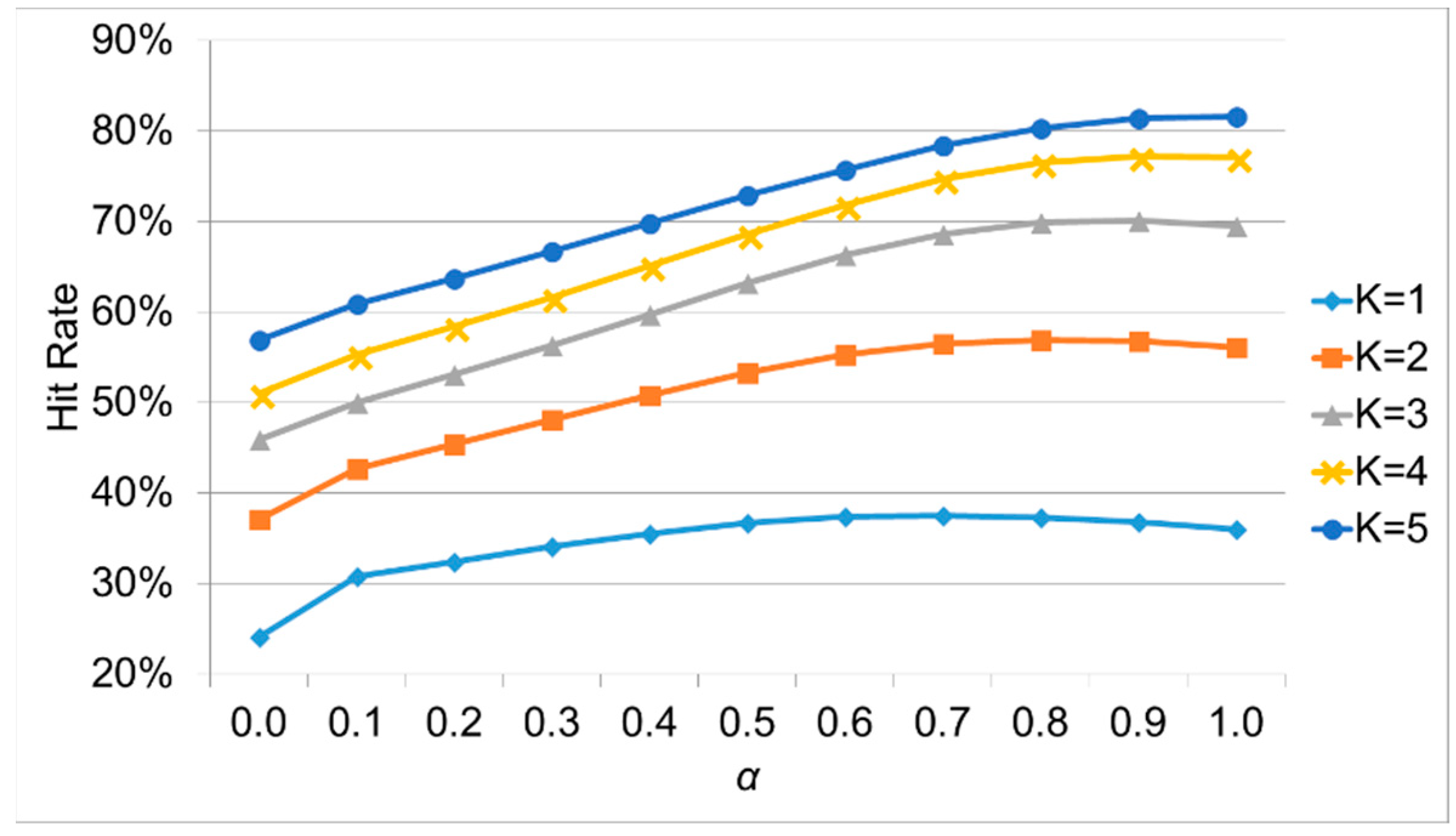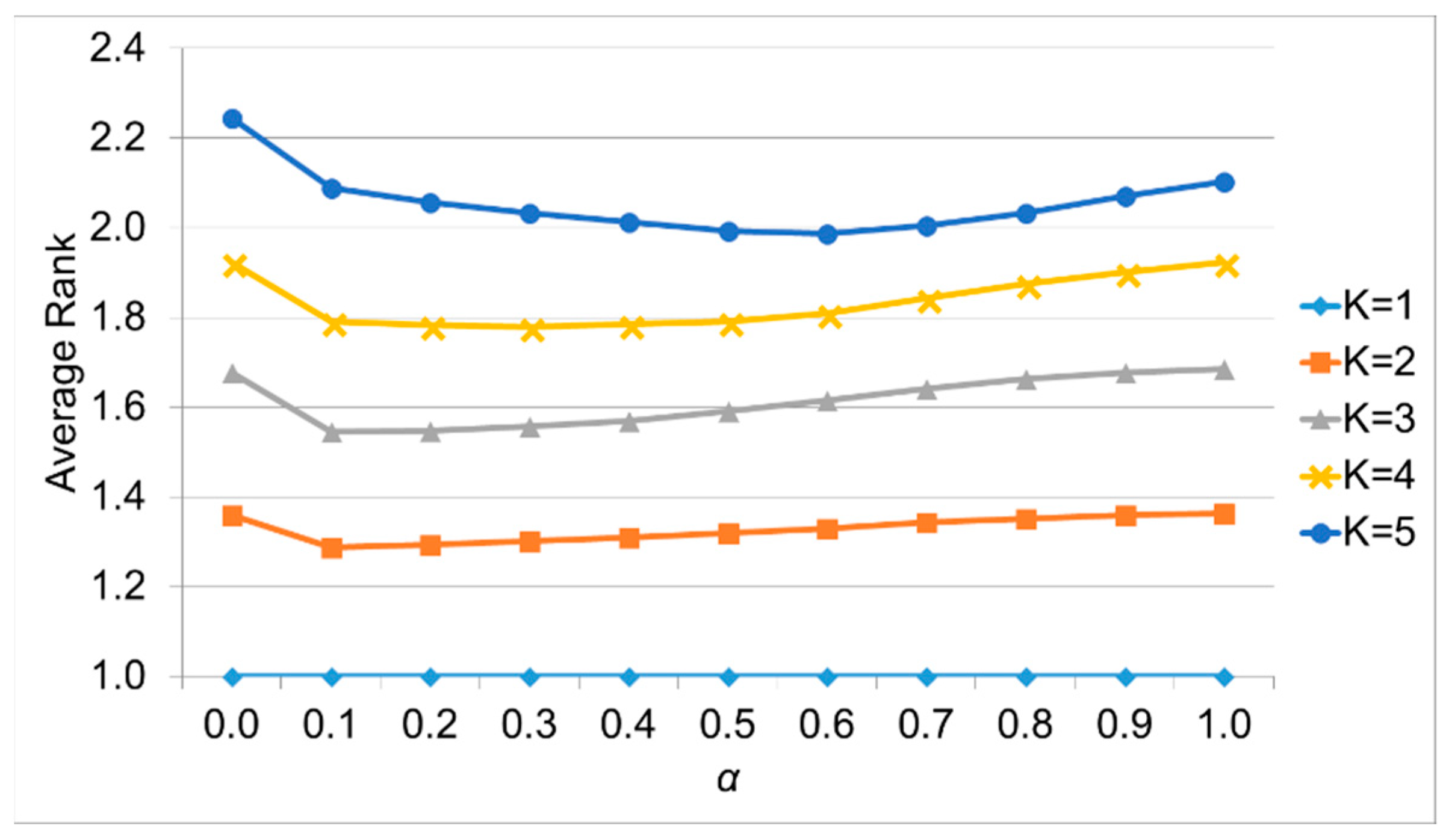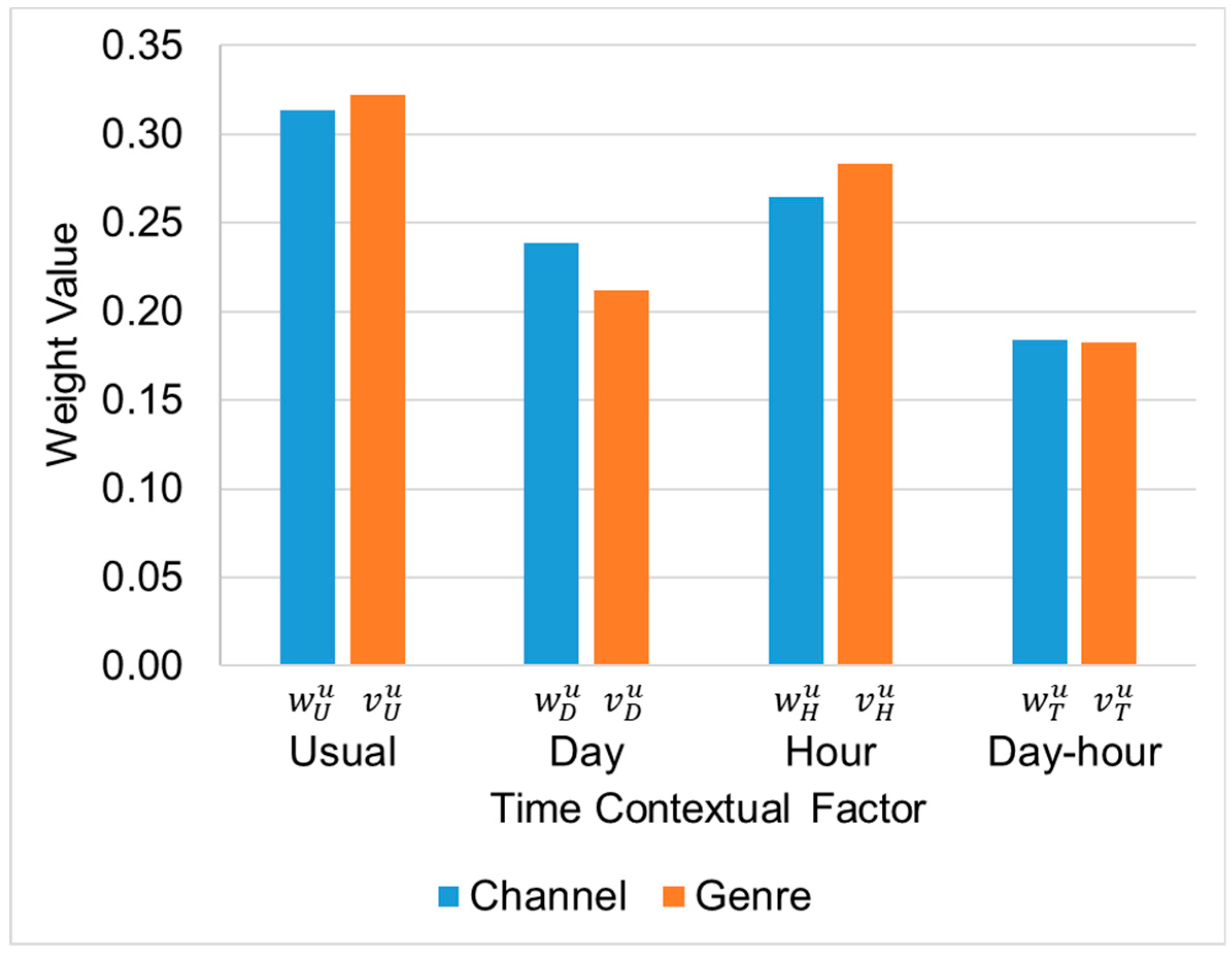A Television Recommender System Learning a User’s Time-Aware Watching Patterns Using Quadratic Programming
Abstract
:1. Introduction
2. Related Work
2.1. Context-Free TV Recommender Systems
2.2. Time-Aware TV Recommender Systems
3. Proposed Method
3.1. Multi-Time Contextual Profiling
3.2. Optimizing the Weights of Time Contextual Factors
3.3. Calculating Recommendation Scores
4. Evaluation
4.1. Experimental Setting
4.2. Performance Comparison
4.3. Parameter Analysis
4.4. Effects of External User Information
5. Conclusions
Author Contributions
Funding
Conflicts of Interest
References
- Portugal, I.; Alencar, P.; Cowan, D. The use of machine learning algorithms in recommender systems: A systematic review. Expert Syst. Appl. 2018, 97, 205–227. [Google Scholar] [CrossRef] [Green Version]
- Harrison, C.; Amento, B.; Stead, L. iEPG: An ego-centric electronic program guide and recommendation interface. ACM Int. Conf. Proc. Ser. 2008, 291, 23–26. [Google Scholar] [CrossRef]
- Ehrmantraut, M.; Härder, T.; Wittig, H.; Steinmetz, R. The personal electronic program guide—Towards the pre-selection of individual TV programs. In Proceedings of the Fifth International Conference on Information and Knowledge Management (CIKM ’96), Rockville, MD, USA, 12–16 November 1996; pp. 243–250. [Google Scholar]
- Engelbert, B.; Blanken, M.B.; Kruthoff-Bruwer, R.; Morisse, K. A user supporting personal video recorder by implementing a generic Bayesian classifier based recommendation system. In Proceedings of the 2011 IEEE International Conference on Pervasive Computing and Communications Workshops (PERCOM Workshops), Seattle, WA, USA, 21–25 March 2011; pp. 567–571. [Google Scholar]
- Quan, J.-C.; Cho, S.-B. A Hybrid Recommender System Based on AHP That Awares Contexts with Bayesian Networks for Smart TV. In International Conference on Hybrid Artificial Intelligence Systems (HAIS 2014); Springer: Cham, Switzerland, 2014; pp. 527–536. [Google Scholar]
- Chaudhry, M.U.; Oh, S.; Kim, N.; Lee, J.H. Heterogeneous Information Network based TV Program Recommendation. In Proceedings of the 16th International Symposium Advanced Intelligent Systems, Mokpo, Korea, 4–7 November 2015; pp. 808–815. [Google Scholar]
- Hsu, S.H.; Wen, M.-H.; Lin, H.-C.; Lee, C.-C.; Lee, C.-H. AIMED—A Personalized TV Recommendation System. In Interactive TV: A Shared Experience; Springer: Berlin/Heidelberg, Germany, 2007; pp. 166–174. [Google Scholar]
- Smyth, B.; Cotter, P. A personalised TV listings service for the digital TV age. Knowl. Based Syst. 2000, 13, 53–59. [Google Scholar] [CrossRef]
- Antonelli, F.; Francini, G.; Geymonat, M.; Lepsøy, S. DynamicTV: A Culture-aware Recommender. In Proceedings of the Third ACM Conference on Recommender Systems, New York, NY, USA, 23–25 October 2009; pp. 257–260. [Google Scholar]
- Martínez, A.B.B.; Arias, J.J.P.; Vilas, A.F.; Duque, J.G.; Nores, M.L. What’s on TV Tonight? An Efficient and Effective Personalized Recommender System of TV Programs. IEEE Trans. Consum. Electron. 2009, 55, 286–294. [Google Scholar] [CrossRef]
- Hölbling, G.; Thalhammer, A.; Kosch, H. Content-based tag generation to enable a tag-based collaborative tv-recommendation system. In Proceedings of the 8th International Conference on Interactive TV and Video (EuroITV ’10), Tampere, Finland, 9–11 June 2010; p. 273. [Google Scholar] [CrossRef]
- Kim, E.; Pyo, S.; Park, E.; Kim, M. An automatic recommendation scheme of TV program contents for (IP)TV personalization. IEEE Trans. Broadcast. 2011, 57, 674–684. [Google Scholar] [CrossRef]
- Oh, J.; Sung, Y.; Kim, J.; Humayoun, M.; Park, Y.H.; Yu, H. Time-dependent user profiling for TV recommendation. In Proceedings of the 2nd International Conference on Cloud and Green Computing and 2nd International Conference on Social Computing and Its Applications, CGC/SCA 2012, Xiangtan, China, 1–3 November 2012; pp. 783–787. [Google Scholar]
- Turrin, R.; Condorelli, A.; Cremonesi, P.; Pagano, R. Time-based TV programs prediction. In Proceedings of the 1st Workshop on Recommender Systems for Television and Online Video (RecSysTV) 2014, Foster City, CA, USA, 6–10 October 2014. [Google Scholar]
- Yuan, J.; Sivrikaya, F.; Hopfgartner, F.; Lommatzsch, A.; Mu, M. Context-aware LDA: Balancing Relevance and Diversity in TV Content Recommenders. In Proceedings of the 2nd Workshop on Recommender Systems for Television and Online Video (RecSysTV) 2015, Vienna, Austria, 16–20 September 2015. [Google Scholar]
- Oh, J.; Kim, S.; Kim, J.; Yu, H. When to recommend: A new issue on TV show recommendation. Inf. Sci. 2014, 280, 261–274. [Google Scholar] [CrossRef]
- Oh, S.; Lee, J.H. Personalized TV Channel Recommendation Considering Viewer’s Time Dependent Propensity Using Constrained Optimization Technique. In Proceedings of the 16th International Symposium Advanced Intelligent Systems, Mokpo, Korea, 4–7 November 2015; pp. 817–824. [Google Scholar]
- Cremonesi, P.; Turrin, R. Time-evolution of IPTV recommender systems. In Proceedings of the 8th International Conference on Interactive TV and Video (EuroITV ’10), Tampere, Finland, 9–11 June 2010; pp. 105–114. [Google Scholar] [CrossRef]
- Oh, S.; Kim, N.R.; Lee, J.; Lee, J.H. Comparison of techniques for time aware TV channel recommendation. In Proceedings of the 2014 Joint 7th International Conference on Soft Computing and Intelligent Systems (SCIS 2014) and 15th International Symposium on Advanced Intelligent Systems (ISIS 2014), Kitakyushu, Japan, 3–6 December 2014; pp. 989–992. [Google Scholar]
- da Silva, F.; Alves, L. PersonalTVware: An Infrastructure to Support the Context-Aware Recommendation for Personalized Digital TV. Int. J. Comput. Theory Eng. 2012, 4, 131–136. [Google Scholar] [CrossRef]
- Park, Y.; Oh, J.; Yu, H. RecTime: Real-Time recommender system for online broadcasting. Inf. Sci. 2017, 409–410, 1–16. [Google Scholar] [CrossRef]
- Barraza-Urbina, A.; Hromic, H.; Heitmann, B.; Hulpus, I.; Hayes, C. Using social media data for online television recommendation services at RTÉ Ireland. In Proceedings of the 2nd Workshop on Recommender Systems for Television and Online Video (RecSysTV) 2015, Vienna, Austria, 16–20 September 2015. [Google Scholar]
- Chang, N.; Irvan, M.; Terano, T. A TV program recommender framework. Procedia Comput. Sci. 2013, 22, 561–570. [Google Scholar] [CrossRef]
- Wang, X.; Sun, L.; Wang, Z.; Meng, D. Group recommendation using external followee for social TV. In Proceedings of the 2012 IEEE International Conference on Multimedia and Expo, Melbourne, Australia, 9–13 July 2012; pp. 37–42. [Google Scholar]
- Rosaci, D.; Sarné, G.M.L.; Garruzzo, S. MUADDIB: A distributed recommender system supporting device adaptivity. ACM Trans. Inf. Syst. 2009, 27, 1–41. [Google Scholar] [CrossRef]
- Rosaci, D.; Sarné, G.M.L. Cloning mechanisms to improve agent performances. J. Netw. Comput. Appl. 2013, 36, 402–408. [Google Scholar] [CrossRef]
- Chung, Y.; Kim, N.; Park, C.; Lee, J. Improved Neighborhood Search for Collaborative Filtering. Int. J. FUZZY Log. Intell. Syst. 2018, 18, 29–40. [Google Scholar] [CrossRef] [Green Version]
- Wei, J.; He, J.; Chen, K.; Zhou, Y.; Tang, Z. Collaborative filtering and deep learning based recommendation system for cold start items. Expert Syst. Appl. 2017, 69, 1339–1351. [Google Scholar] [CrossRef]
- Rosaci, D. Finding semantic associations in hierarchically structured groups of Web data. Form. Asp. Comput. 2015, 27, 867–884. [Google Scholar] [CrossRef]





| Method | K = 1 | K = 2 | K = 3 | K = 4 | K = 5 |
|---|---|---|---|---|---|
| kNN | 24.31 | 41.59 | 53.16 | 60.15 | 65.73 |
| SVD | 25.93 | 39.31 | 48.20 | 54.69 | 59.49 |
| Pop_usual | 29.51 | 51.08 | 67.09 | 75.89 | 80.79 |
| Pop_day | 30.30 | 51.15 | 65.84 | 74.14 | 79.15 |
| Pop_hour | 33.20 | 53.93 | 67.78 | 75.68 | 80.19 |
| Pop_dayhour | 34.02 | 52.61 | 64.83 | 73.57 | 78.38 |
| QP_log | 35.49 | 55.41 | 69.04 | 76.87 | 81.41 |
| Proposed | 37.31 | 56.91 | 69.90 | 76.56 | 80.35 |
| Method | K = 1 | K = 2 | K = 3 | K = 4 | K = 5 |
|---|---|---|---|---|---|
| kNN | 1.00 | 1.30 | 1.62 | 1.87 | 2.09 |
| SVD | 1.00 | 1.24 | 1.53 | 1.79 | 2.02 |
| Pop_usual | 1.00 | 1.43 | 1.81 | 2.07 | 2.26 |
| Pop_day | 1.00 | 1.41 | 1.77 | 2.03 | 2.24 |
| Pop_hour | 1.00 | 1.39 | 1.73 | 1.97 | 2.15 |
| Pop_dayhour | 1.00 | 1.36 | 1.68 | 1.96 | 2.16 |
| QP_log | 1.00 | 1.37 | 1.69 | 1.94 | 2.12 |
| Proposed | 1.00 | 1.35 | 1.66 | 1.88 | 2.03 |
| Method | K = 1 | K = 2 | K = 3 | K = 4 | K = 5 |
|---|---|---|---|---|---|
| QP_global | 25.42 | 47.52 | 62.78 | 70.38 | 73.22 |
| QP_fusion | 37.32 | 57.05 | 70.20 | 76.85 | 80.63 |
| Proposed | 37.31 | 56.91 | 69.90 | 76.56 | 80.35 |
| Method | K = 1 | K = 2 | K = 3 | K = 4 | K = 5 |
|---|---|---|---|---|---|
| QP_global | 1.00 | 1.47 | 1.85 | 2.10 | 2.23 |
| QP_fusion | 1.00 | 1.35 | 1.67 | 1.88 | 2.03 |
| Proposed | 1.00 | 1.35 | 1.66 | 1.88 | 2.03 |
© 2018 by the authors. Licensee MDPI, Basel, Switzerland. This article is an open access article distributed under the terms and conditions of the Creative Commons Attribution (CC BY) license (http://creativecommons.org/licenses/by/4.0/).
Share and Cite
Kim, N.-r.; Oh, S.; Lee, J.-H. A Television Recommender System Learning a User’s Time-Aware Watching Patterns Using Quadratic Programming. Appl. Sci. 2018, 8, 1323. https://doi.org/10.3390/app8081323
Kim N-r, Oh S, Lee J-H. A Television Recommender System Learning a User’s Time-Aware Watching Patterns Using Quadratic Programming. Applied Sciences. 2018; 8(8):1323. https://doi.org/10.3390/app8081323
Chicago/Turabian StyleKim, Noo-ri, Sungtak Oh, and Jee-Hyong Lee. 2018. "A Television Recommender System Learning a User’s Time-Aware Watching Patterns Using Quadratic Programming" Applied Sciences 8, no. 8: 1323. https://doi.org/10.3390/app8081323




